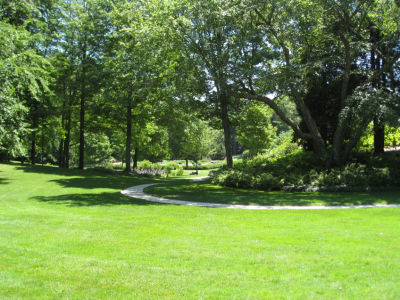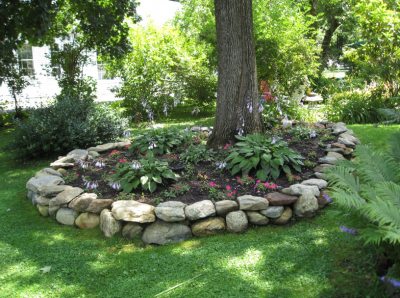Growing healthy grass under shaded conditions is often a challenge for homeowners. Shade occurs, to some degree, in almost all lawns. Shade problems for turf may be reduced by improving the growing environment, selecting the proper variety of grass, or altering turfgrass management practices. It is important to have an understanding as to how shade affects turfgrass growth before discussing the corrective measures that may improve the overall health and quality of the turf under shaded conditions.
The Shade Environment
Most turfgrasses require four to five hours of full sun, or a full day of filtered sunlight. In the majority of cases, shade problems are the result of either dense tree canopies or locations on the north side of homes. Time of year also will have an effect on shade as the angle of the sun changes throughout the year. Turfgrass growth is affected by the intensity, duration, and quality of light. Shade interferes with light wavelengths that are necessary for carbohydrate production through the process of photosynthesis. The light wavelengths necessary for carbohydrate production are mainly orange, red, and blue light. Light that filters through a tree canopy to the turf below is usually low in these wavelengths. The result is lower photosynthesis, which leads to a reduction in carbohydrate production.
When carbohydrate production drops, turf quality is negatively affected in a number of ways, including reductions in tiller production, rhizome development, and root growth. Other symptoms that shaded turf may exhibit include succulent growth, finer leaf texture, reduced shoot growth and density, upright growth habit, increased leaf length, and an overall deterioration in plant vigor. As a consequence, the turf ‘thins out’ and becomes more susceptible to the stresses of drought, disease, heat, cold and wear.
Tree growth, age, and species will affect the different light wavelengths that shade turf. For example, a birch tree or a locust may allow light to filter through the foliage while large, densely canopied trees such as maples and oaks will absorb more of the light wavelengths needed for turfgrass growth. Newly planted trees create very little permanent shade. When selecting landscape plants be aware of tree or shrub characteristics at maturity and how they may affect turfgrass growth. A few questions that should be answered before purchasing or planting should be: how tall will the tree/trees be at maturity, how dense will the tree canopy become, and what are the rooting characteristics of the trees or shrubs that are being selected? Shallow rooted trees should be avoided in areas where turf grasses are a priority. Tree roots compete for nutrients and water and may cause the turf to suffer from nutrient deficiencies or drought stress. Shallow roots can also damage lawn mowers. Many times, in shaded environments turfgrass vigor is not only affected by shade, but by lack of air movement. Air flow can be impeded by obstructions such as houses, sheds, or more commonly underbrush and low branches. Lack of light and air flow can result in an increase in the relative humidity, prolong leaf and soil wetness after rainfall or irrigation, and extend dew retention. These conditions can lead to turfgrass disease and/or moss infestations. In fact, much of the turfgrass thinning in shaded conditions is the result of a combination of low light intensity, high relative humidity (disease), and root competition.

Improving the Growing Environment
The growing environment can be improved by selectively removing trees or pruning branches (minimum 8-10 feet above ground level). This will reduce shade and improve air movement at the turf canopy. The result is increased light penetration and lower relative humidity, which could lead to a reduction in disease. It has been reported that morning sunlight is more beneficial than afternoon. One of the thoughts behind this theory is that the grass dries out in the morning sun and is less susceptible to disease. However, more research is needed before this recommendation can be made. Before making the decision to selectively remove trees, one might try to prune trees and remove underbrush. Very often selective tree removal and pruning provides positive results. If pruning alone does not improve the turfgrass quality, then selective tree removal may be necessary. The decision to remove trees is not an easy one. What it comes down to in many cases is that a choice has to be made between a tree and grass.
Grass Species Selection
Another way that may help to increase turfgrass performance in shaded environments would be to plant turfgrasses that are better adapted to low light intensities. Table 1 illustrates turfgrass performance under shaded conditions.
TABLE I
Shade Tolerance of Common Cool Season Grasses Utilized in Home Lawns
| Excellent | Good/Medium | Poor |
| Creeping red fescue*
Chewings fescue* Hard fescue* Rough bluegrass** |
Turf Type tall fescue
‘Select’ Kentucky bluegrass cultivars |
Kentucky bluegrass
Annual ryegrass Perennial ryegrass |
* grasses that perform best in dry shaded conditions
** grasses that perform best in wet shaded conditions
Management Practices for Growing Turf in Shade
Modifications of fertilization, irrigation, and mowing practice will improve turfgrass quality.
Fertilization: nitrogen rates should be reduced to at least ½ the rate that is being utilized for turf grown in full sun. Often, turf can just be fertilized once a year in spring or early fall. High nitrogen fertilization increases succulence that may result in increased disease and traffic injury. Nitrogen also encourages the top growth of the plant at the expense of root growth.
Irrigation: In areas of dense shade, monitor soil moisture levels prior to watering your lawn. A reduction in soil and leaf wetness will promote healthier turf by decreasing turfgrass succulence and the chance for disease infection. If water is necessary, water deeply and infrequently. When utilizing an underground sprinkler system, the irrigation system should be designed in such a way that allows areas of the lawn (in the shade) to be turned off or ‘run times’ reduced.
Mowing: Increase the mowing height in shaded areas by 0.5-1.0 inch. The increased leaf surface area will increase the ability of the plant to absorb more light. A higher mowing height will also result in a deeper root system, which will improve the availability of water and nutrients to the plant.
Soil pH: Soil tests should be taken periodically to determine soil pH. If soil pH is below the recommended level, turf quality will be reduced. If the area is wet, poorly drained, and acidic, moss and algae problems can develop. Extended leaf and debris cover from the fall can also increase soil acidity.
Leaf removal: In the fall remove leaves frequently from turf under tree canopies. A thick layer of leaves over weakened turf will further aggravate the poor growing conditions. Increased incidences of disease, lower pH or complete death to the plant due to lack of light and oxygen are often the result.

By Steven Rackliffe, Extension Instructor Emeritus, Plant Science & Landscape Architecture 2013, reviewed by D. Pettinelli, 2024
Questions? Contact:
UConn Soil Nutrient Analysis Laboratory
Department of Plant Science and Landscape Architecture
Phone: 860.486.4274
Email: soiltest@uconn.edu
Website: soiltesting.cahnr.uconn.edu
UConn is an equal opportunity program provider and employer.
©UConn Extension. All rights reserved.